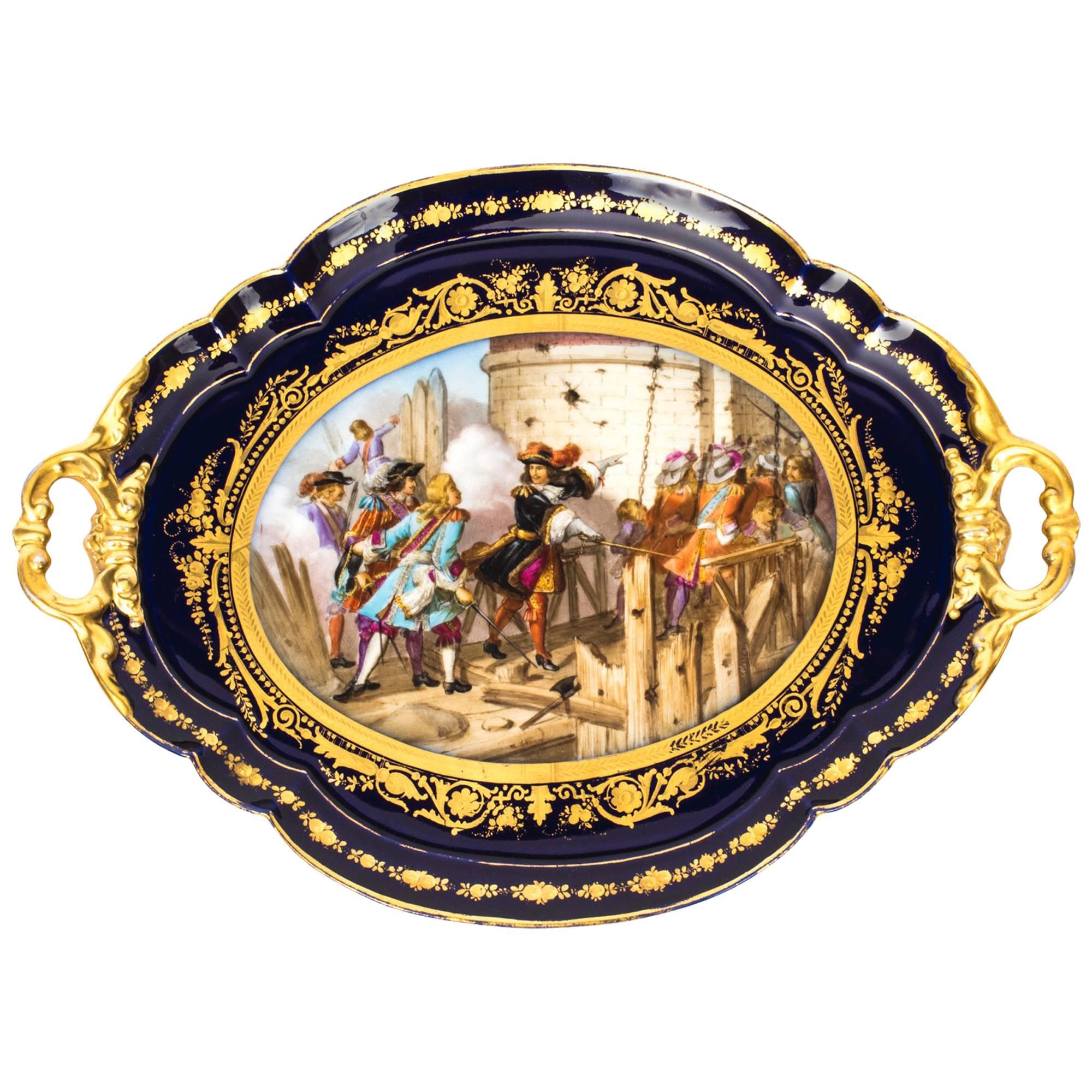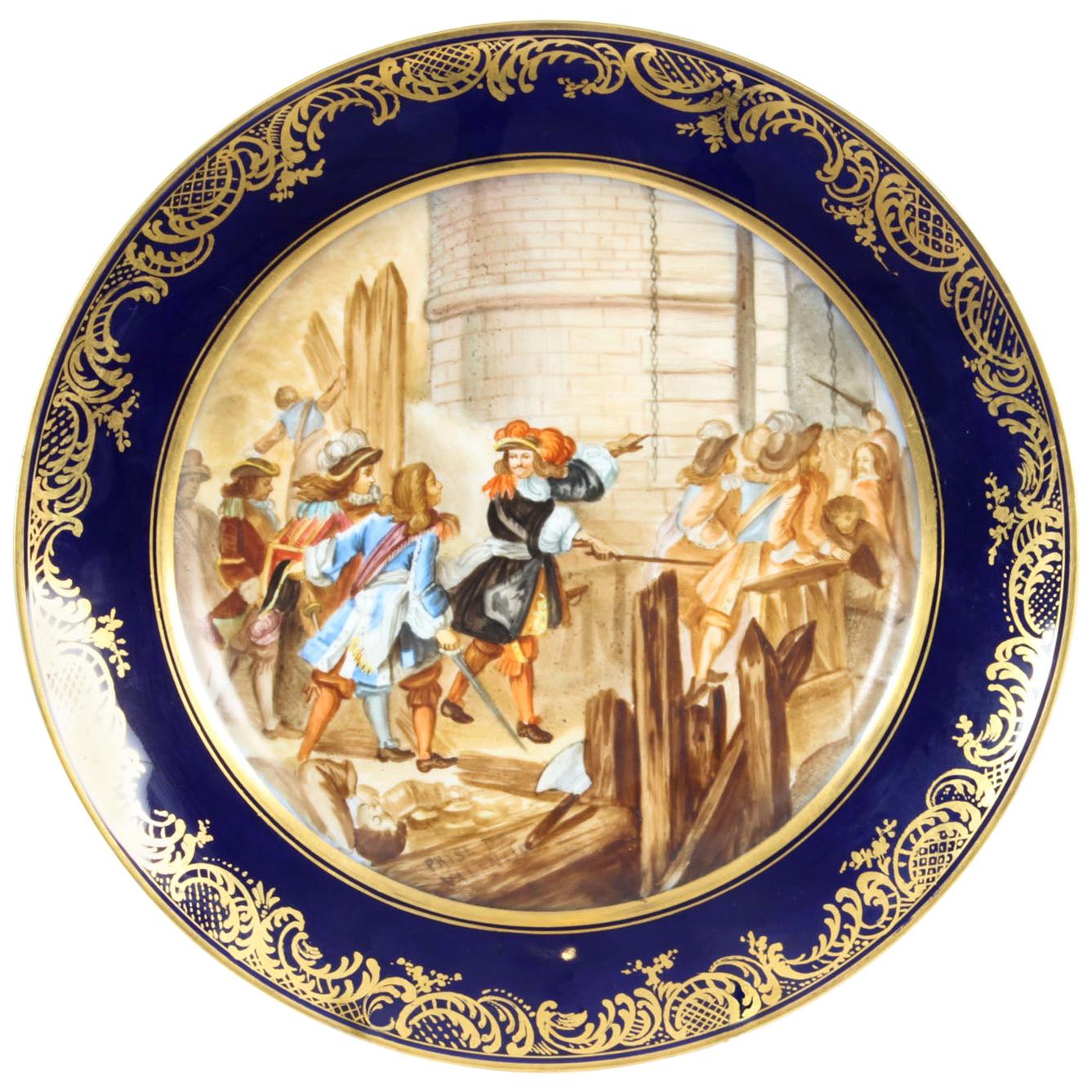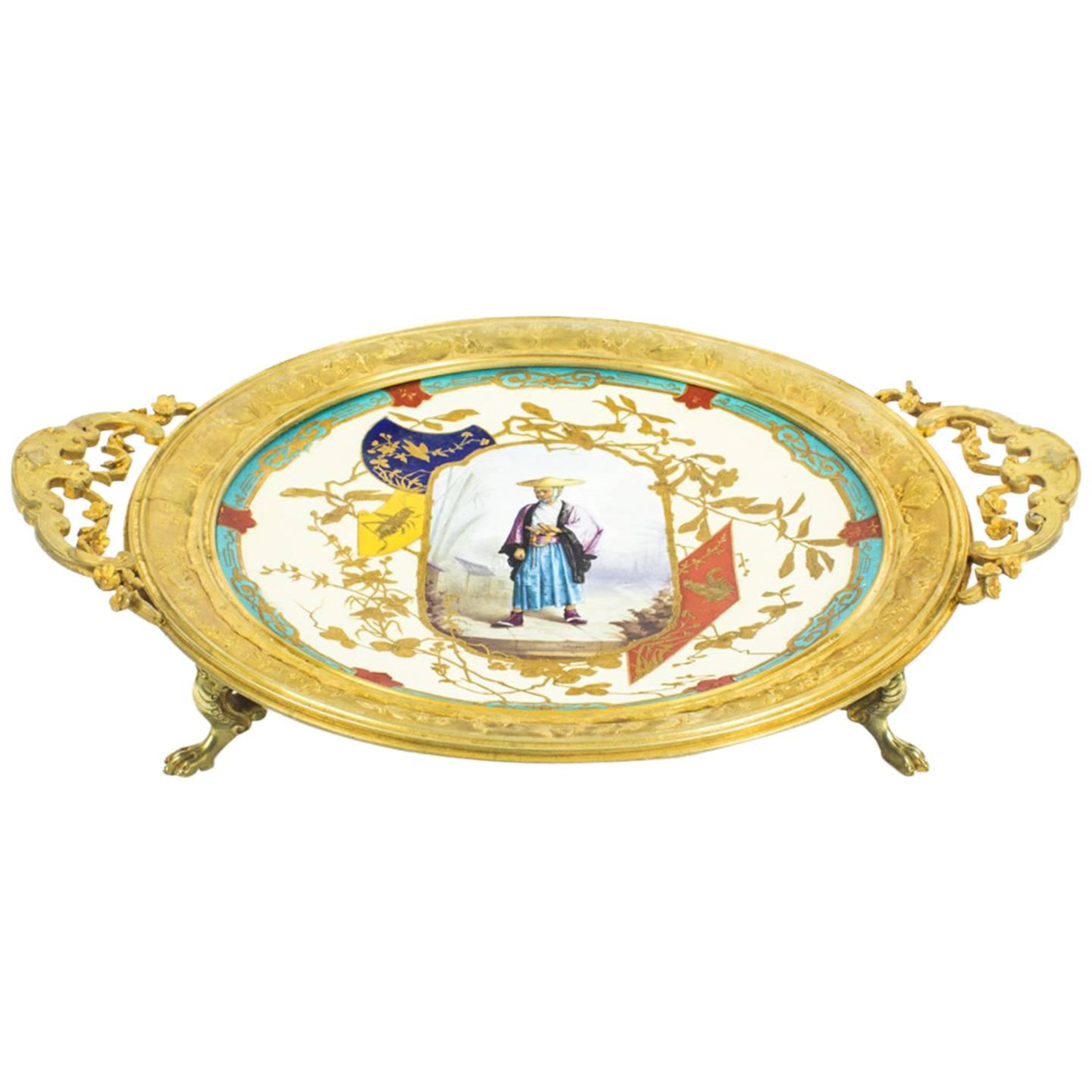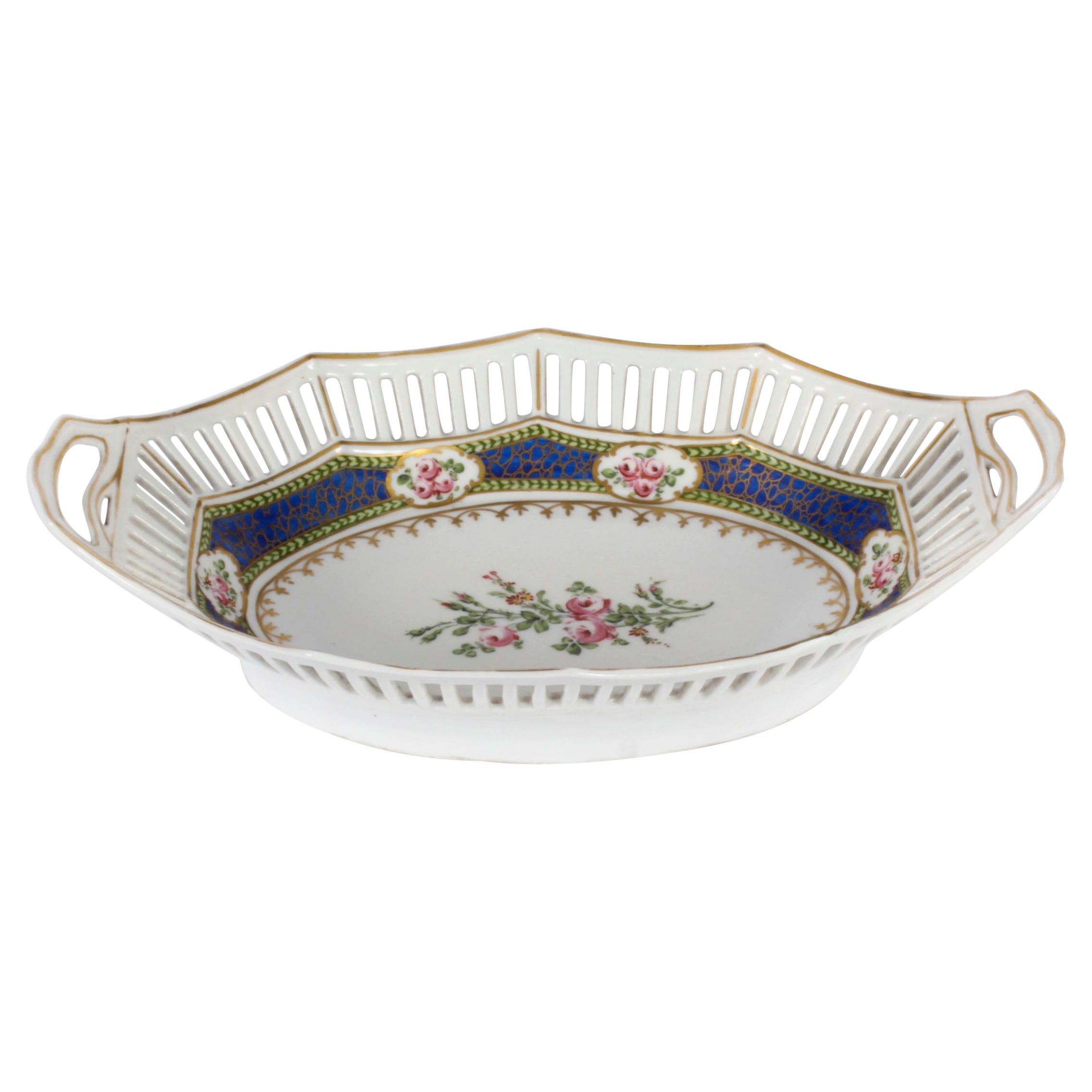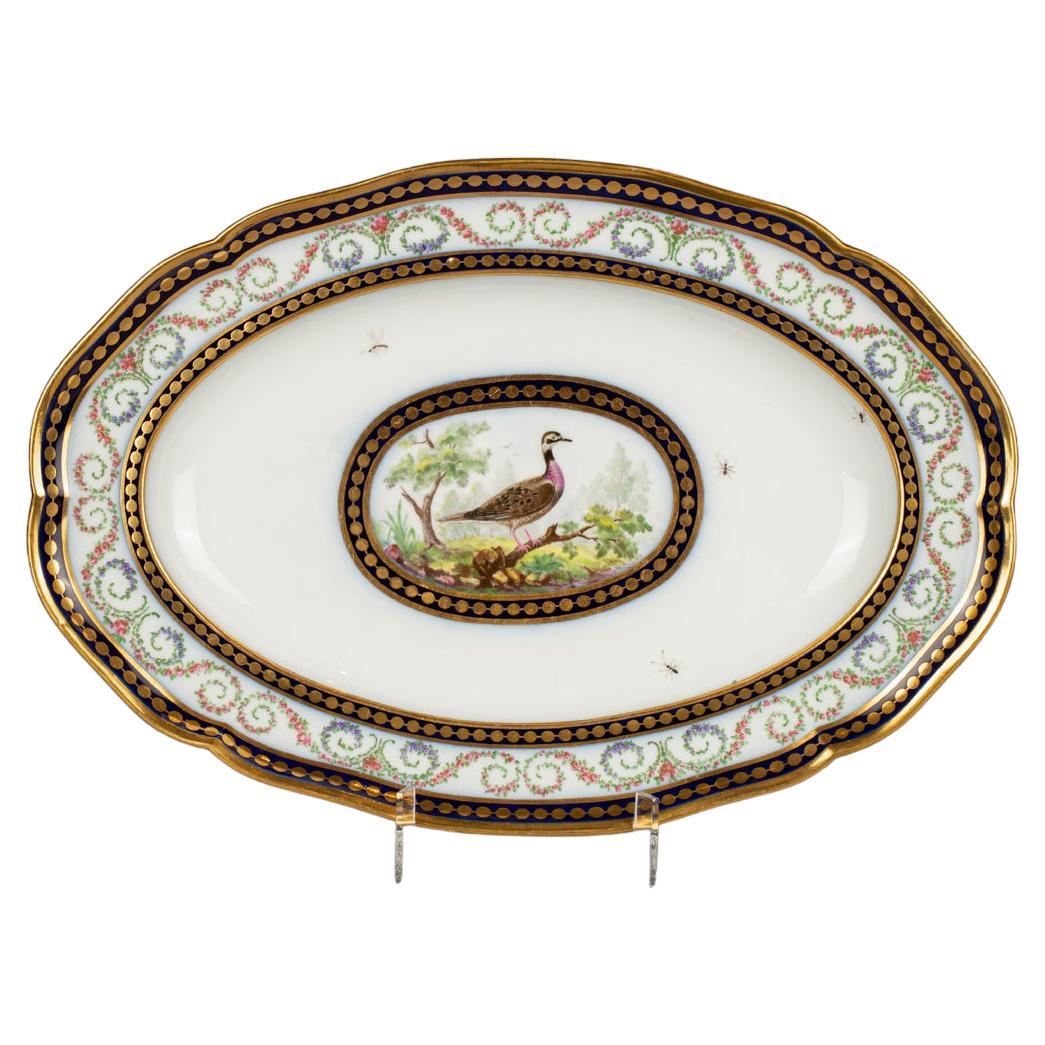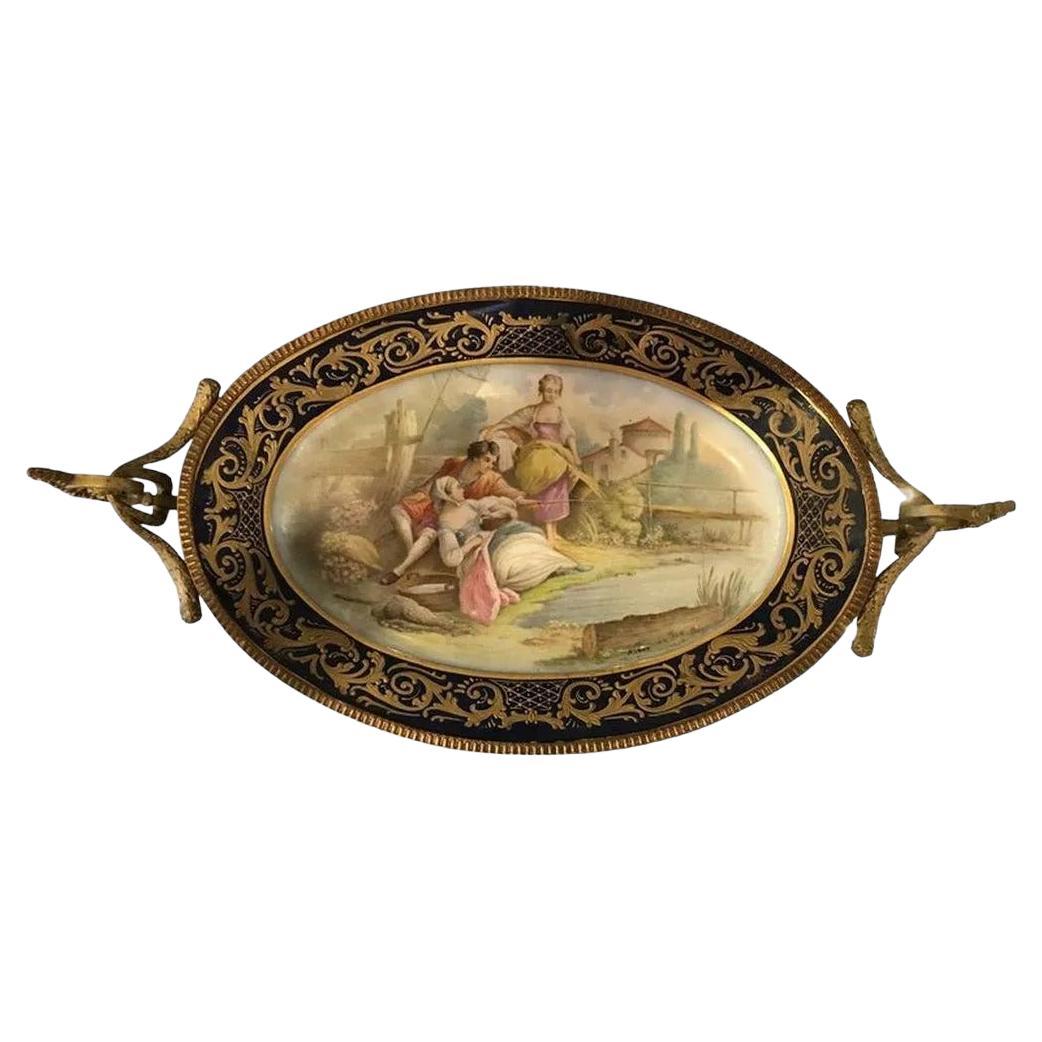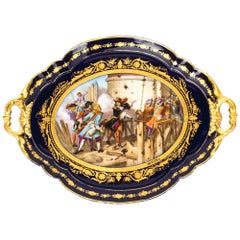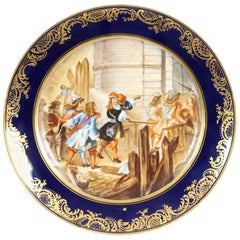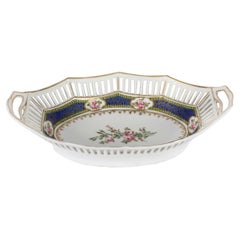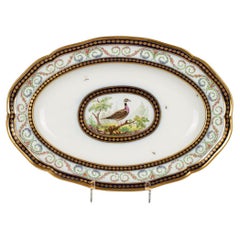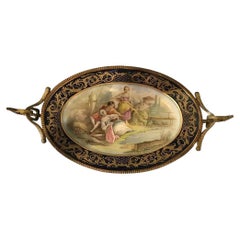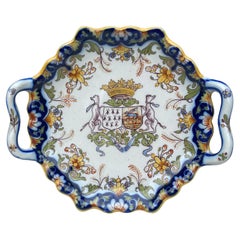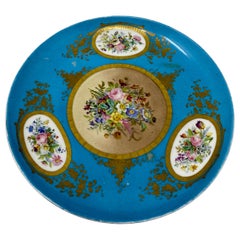Items Similar to Antique French Sevres Oval Porcelain Dish, Late 18th Century
Video Loading
Want more images or videos?
Request additional images or videos from the seller
1 of 16
Antique French Sevres Oval Porcelain Dish, Late 18th Century
$2,810.87
£2,050
€2,390.87
CA$3,849.04
A$4,279.60
CHF 2,234.57
MX$52,093.21
NOK 28,512.18
SEK 26,714.55
DKK 17,843.51
Shipping
Retrieving quote...The 1stDibs Promise:
Authenticity Guarantee,
Money-Back Guarantee,
24-Hour Cancellation
About the Item
This is an important decorative antique French Sevres oval porcelain dish, the rear with underglaze blue interlaced LL factory Sevres mark, late 18th century in date.
The oval border is a striking Bleu Royal colour and the centre is masterfully hand painted with a scene depicting the Battle of Ravenna. The gilt and 'jewelled' fleur de lys border is interspersed with six panels hand painted with portraits. The rear bears the interlaced L marks for Sevres, and the names and titles of the portraits in blue.
There is no mistaking the quality and unique design of this charger which is sure to be a treasured addition to your home.
Condition:
In excellent condition with no chips, cracks or signs of repair, and only very minor signs of wear comensurate with age and use, please see photos for confirmation of condition.
Dimensions in cm:
Height 3 x Width 35 x Depth 25
Dimensions in inches:
Height 1 inch x Width 1 foot, 2 inches x Depth 10 inches
Sevres Porcelain
traces its roots in France to early craftsmen who had small manufacturing operations in such places as Lille, Rouen. St. Cloud, and most notably Chantilly. It is from Chantilly that a cadre of workers migrated to the Chateau de Vincennes near Paris to form a larger porcelain manufactory in 1738.
French King Louis XV, perhaps inspired by his rumoured relationship with mistress Madame de Pompadour, took an intense interest in porcelain and moved the operation in 1756 to even larger quarters in the Paris suburb of Sevres. Sevres was also conveniently near the home of Madame de Pompadour and the King's own Palace at Versailles.
From the outset the king's clear aim was to produce Sevres Porcelain that surpassed the established Saxony works of Meissen and Dresden. Though the French lacked an ample supply of kaolin, a required ingredient for hard-paste porcelain (pate dure), their soft-paste porcelain (pate tendre) was fired at a lower temperature and was thus compatible with a wider variety of colours and glazes that in many cases were also richer and more vivid. Unglazed white Sevres Porcelain "biscuit" figurines were also a great success. However, soft-paste Sevres Porcelain was more easily broken. Therefore, early pieces of Sevres Porcelain that remain intact have become rare indeed.
The Sevres Porcelain manufactory always seemed to be in dire financial straits despite the incredibly fine works it produced. In fact, the king's insistence that only the finest items be created may have contributed to the difficulties. Only a limited number of European nobility could afford the extravagant prices demanded for such works. King Louis XV and eventually his heir, the ill-fated Louis XVI, were obliged to invest heavily in the enterprise. Ultimately, the Sevres Porcelain Factory produced items under the name of "Royal" and thus the well-known Sevres mark was born. King Louis XV even mandated laws that severely restricted other porcelain production in France so as to retain a near monopoly for his Sevres Porcelain. The king even willingly became chief salesman for the finest of his products, hosting an annual New Year's Day showing for French nobility in his private quarters at Versailles. He eagerly circulated among potential buyers, pitching the merits of ownership and policing the occasional light-fingered guest.
Sevres Porcelain may have indeed given the makers of Meissen and Dresden a run for their money by the end of the 18th Century but for the French Revolution. By 1800, the Sevres Porcelain Works were practically out of business due to the economic devastation of the new French Republic.
About the time when Napoleon Bonaparte named himself Emperor of France (1804), a new director was named for the Sevres Porcelain Manufactory. Alexandre Brongniart, highly educated in many fields, resurrected Sevres Porcelain. Soft-paste porcelain was eliminated altogether thanks to the earlier discovery of kaolin near Limoges. For four decades until his death, Brongniart presided over monumental progress for Sevres Porcelain, catering not only to Napoleon himself, but at last to include the more financially profitable mid-priced market in the emerging middle class.
The Battle of Ravenna, fought on 11 April 1512, was a major battle of the War of the League of Cambrai. It pitted forces of the Holy League against France and their Ferrarese allies. Although the French and Ferrarese eliminated the Papal-Spanish forces as a serious threat, their triumph was overshadowed by the loss of their young general Gaston of Foix. The victory therefore did not help them secure northern Italy. The French withdrew entirely from Italy in the summer of 1512, as Swiss mercenaries hired by Pope Julius II and Imperial troops under Emperor Maximilian I arrived in Lombardy. The Sforza were restored to power in Milan.
About the Seller
5.0
Platinum Seller
Premium sellers with a 4.7+ rating and 24-hour response times
Established in 1983
1stDibs seller since 2012
1,374 sales on 1stDibs
Typical response time: <1 hour
Associations
LAPADA - The Association of Arts & Antiques Dealers
- ShippingRetrieving quote...Shipping from: London, United Kingdom
- Return Policy
Authenticity Guarantee
In the unlikely event there’s an issue with an item’s authenticity, contact us within 1 year for a full refund. DetailsMoney-Back Guarantee
If your item is not as described, is damaged in transit, or does not arrive, contact us within 7 days for a full refund. Details24-Hour Cancellation
You have a 24-hour grace period in which to reconsider your purchase, with no questions asked.Vetted Professional Sellers
Our world-class sellers must adhere to strict standards for service and quality, maintaining the integrity of our listings.Price-Match Guarantee
If you find that a seller listed the same item for a lower price elsewhere, we’ll match it.Trusted Global Delivery
Our best-in-class carrier network provides specialized shipping options worldwide, including custom delivery.More From This Seller
View All19th Century French Sevres Porcelain Tray Signed Moreaux
Located in London, GB
This is an absolutely fabulous antique Sevres porcelain oval two-handled tray, dating from the mid-19th century.
Beautifully hand-painted and commemorating a 1677 battle scene, the ...
Category
Antique 1860s French Porcelain
Materials
Porcelain
Antique French Sevres Porcelain Gilt Plate "Prise de Valence", 19th Century
Located in London, GB
This is a beautiful antique French Sevres porcelain cabinet plate, dating from the late 19th century.
This superbly hand painted plate feat...
Category
Antique 1890s French Porcelain
Materials
Porcelain
Antique French "Japonesque" Porcelain dish by Louis Pierre Malpass 19th C
Located in London, GB
This is an absolutely fabulous antique French "Japonesque" ormolu mounted porcelain tripod dish, late 19th century in date.
It bears the signature of Louis-Pierre Malpass, one of th...
Category
Antique 1890s French Porcelain
Materials
Ormolu
Antique French Sevres Oval Porcelain Dish Late 19th Century
Located in London, GB
This is a decorative antique French Sevres oval porcelain dish, dating from Circa 1880.
The oval pierced borderwith gilt highlights with a striking Bleu Royal inner border, the cent...
Category
Antique 1880s French Porcelain
Materials
Porcelain
Antique French Sevres Porcelain Cabinet Plate "Camp du Rap" 19th Century
Located in London, GB
This is a beautiful antique French Sevres porcelain cabinet plate, Circa 1880 in date.
It is superbly hand painted plate and features a ce...
Category
Antique 1880s French Porcelain
Materials
Porcelain
Antique Royal Worcester Porcelain Landscape Dish, 19th Century
By Royal Worcester
Located in London, GB
This is a fine and unique antique Royal Worcester porcelain landscape dish, circa 1840 in date.
The Worcester Royal blue oval sha...
Category
Antique 1840s English Porcelain
Materials
Porcelain
You May Also Like
French Porcelain Platter, Sevres, Dated 1792
Located in New York, NY
This platter comes from a Sèvres dinner service sold to the Dutch banker Jean-Baptiste Vandernyver on 29th November 1792. The platter is marked p...
Category
Antique 1790s Platters and Serveware
Materials
Porcelain
Late 19th Century Sevres Style Porcelain Gilt Bronze Plate
Located in Pasadena, CA
Featuring the finest craftsmanship, materials, and design elements of its given era. Dating to the late 19th century, this gilt bronze center piece is done in the Sevres XVI style and was made in France. The porcelain serving dish or pedestal plate...
Category
Antique 19th Century French French Provincial Platters and Serveware
Materials
Bronze
French Faience Handled Platter Desvres, circa 1900
By Desvres
Located in Austin, TX
Antique French faience handled platter with coat of arms dogs and floral pattern, circa 1900.
Category
Antique Early 1900s French French Provincial Platters and Serveware
Materials
Faience
Antique French Early 19th Century Sèvres Plate, circa 1820-1830
Located in New Orleans, LA
Antique French early 19th century Sèvres plate, circa 1820-1830.
FPR007.
Category
Antique Early 19th Century European Porcelain
Materials
Porcelain
A French 19th century hand painted majolica dish from the Gien factory C 1875
Located in Central England, GB
This most impressive large twin handled table centrepiece is stunning in its fine hand painted detail. It was made in France at the Gien Faience Pottery Works and bears the early fac...
Category
Antique Late 19th Century French Napoleon III Pottery
Materials
Majolica
Rare Sevres, Gilded Bronze Dish, Chateau des Tuileries circa 1840
By Manufacture Nationale de Sèvres
Located in Autonomous City Buenos Aires, CABA
Rare Sevres, gilded bronze dish, platter, depicting a Charming and Angelical Scene, a Lady and a little angel in the countryside in the garden in the background, and garlands of flow...
Category
Antique 1840s French Romantic Centerpieces
Materials
Porcelain
More Ways To Browse
French Oval Portraits
18th Century Sevres
Silver Footed Dish
18th Century Sevres Porcelain
Chateau Panel
Fire King
Sevres Porcelain Napoleon
Limoges France Unique
Imperial Glass Works
Hand Painted Italian Dish
Sevres Porcelain Limoge
Porcelain Bear Figurines
Portrait Of Louis Xv
Very Large Sevres Porcelain
Saxony Porcelain
Dresden Porcelain Figurines
Vincennes Porcelain
Sevres Biscuit
